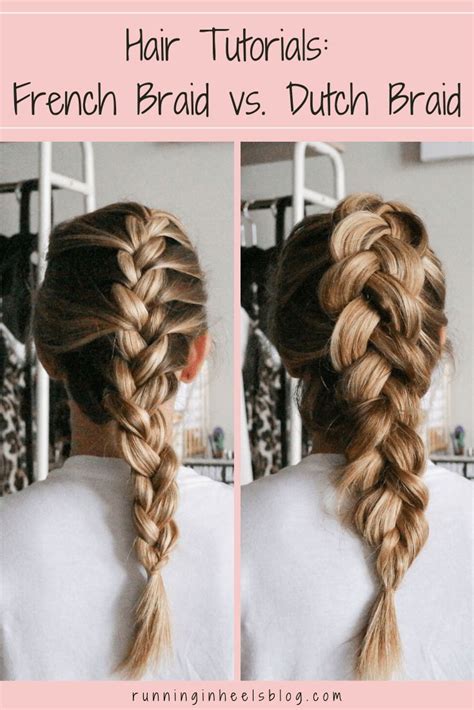Dutch braids and French braids are two of the most popular hairstyles, but they have distinct differences that make them suitable for different occasions and face shapes. This in-depth guide explores the key features, advantages, and disadvantages of Dutch braids versus French braids, empowering you to make an informed decision about the perfect braid style for your needs.

Dutch Braid: An Intricate Crown
Characteristics:
- Also known as a “reverse French braid,” the Dutch braid starts at the base of the crown and works its way upward.
- Three strands of hair are interlaced, but instead of crossing them over each other as in a French braid, they are crossed underneath.
- This creates a raised, voluminous braid that adds height and texture to the hair.
Advantages:
- Elegant and eye-catching: The intricate weave of a Dutch braid makes it a show-stopping hairstyle, ideal for special occasions.
- Volume and lift: By lifting the hair from the roots, Dutch braids enhance the illusion of fullness and volume.
- Versatile: Dutch braids can be styled in various ways, including high, low, or side buns, adding versatility to your hair repertoire.
Disadvantages:
- Time-consuming: Dutch braids are more complex to create than French braids, requiring patience and practice.
- Tightness: If braided too tightly, Dutch braids can cause discomfort or even hair loss.
- Not suitable for fine or thin hair: The weight and volume of a Dutch braid can overwhelm fine or thin hair, making it appear limp or flat.
French Braid: A Classic Cascade
Characteristics:
- A French braid is created by dividing the hair into three sections at the crown.
- The outer strands are crossed over the middle strand, gradually adding hair from the sides as you braid.
- This results in a flat, elegant braid that cascades down the back.
Advantages:
- Versatile: French braids are suitable for a wide range of hair types and textures, from thick and curly to fine and straight.
- Easy to create: The technique is relatively simple, making French braids accessible to beginners.
- Secure: French braids hold hair tightly, preventing flyaways and maintaining a polished look throughout the day.
Disadvantages:
- Can be repetitive: Creating a French braid can become monotonous, especially for long hair.
- Less volume: Compared to Dutch braids, French braids tend to lie flatter against the head, providing less lift and volume.
- Not as elaborate: While elegant, French braids lack the intricate detail and visual impact of Dutch braids.
Comparison Tables
| Characteristic | Dutch Braid | French Braid |
|---|---|---|
| Construction | Starts at base of crown, crosses strands underneath | Starts at crown, crosses strands over each other |
| Volume | High, voluminous | Flat, cascade |
| Time required | More time-consuming | Less time-consuming |
| Complexity | More complex | Simpler |
| Comfort | Can be uncomfortable if braided too tightly | Comfortable |
| Suitability for fine hair | Not recommended | Suitable |
| Occasion | Dutch Braid | French Braid |
|---|---|---|
| Weddings | Yes | Yes |
| Proms | Yes | Yes |
| Casual outings | Yes, if styled casually | Yes, for all occasions |
| Work | Yes, if styled professionally | Yes, for all occasions |
| Sports | Not recommended | Suitable for low-impact activities |
| Face Shape | Dutch Braid | French Braid |
|---|---|---|
| Oval | Yes | Yes |
| Round | Yes, to elongate | Yes, to balance |
| Square | Yes, to soften | Yes, to narrow |
| Diamond | Yes, to widen | Yes, to fill in |
| Heart | Yes, to frame | Yes, to minimize |
Understanding Customer Needs and Motivations
Pain Points:
- Lack of volume or height in hair
- Difficulty creating intricate hairstyles
- Desire for hairstyles that stay in place all day
- Preference for hairstyles that suit various face shapes
Motivations:
- Desire to look elegant and sophisticated
- Want to enhance hair texture and movement
- Need for hairstyles that are practical and versatile
- Interest in timeless and classic hairstyles
FAQs
-
Can I create Dutch braids on short hair?
– Yes, but shorter hair may limit the length and complexity of the braid. -
Should I use hairspray on my Dutch braid?
– Yes, light hairspray can help secure the braid and prevent flyaways. -
How do I prevent my French braid from becoming loose?
– Use hairspray to set the braid and secure it with bobby pins. -
Can I sleep with a Dutch braid?
– Yes, but the braid may become slightly messy overnight. -
Which braid style is better for thick hair?
– Both Dutch and French braids can be styled effectively on thick hair. -
Which braid style is more appropriate for a casual setting?
– Loosely braided French braids offer a more casual look than intricate Dutch braids. -
Can I braid my own hair?
– Yes, with practice and patience, you can create both Dutch and French braids on your own hair. -
What is the difference between a Dutch braid and a fishtail braid?
– Dutch braids interlace three strands of hair, while fishtail braids interlace two strands by dividing each strand in half.
